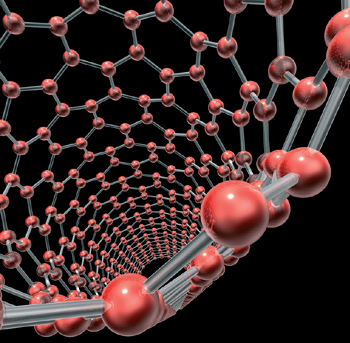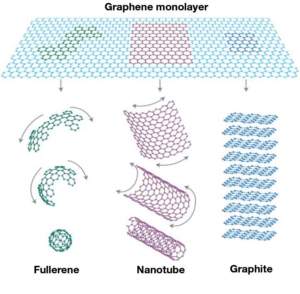
The novel advanced material, graphene, first reported in Science in 2004, consists of single molecular layers of highly crystalline graphite. It is the basic structural element of some carbon allotropes, including graphite, carbon nanotubes and fullerenes. It was isolated for the first time by a collaborative team from the Department of Physics, University of Manchester, UK, and the Institute for Microelectronics Technology, Chernogolovka, Russia.

Figure 1: Graphene is the basic structural element of carbon allotropes such as fullerenes, nanotubes and graphite.[1]
Graphene exhibits excellent electron transport properties which make it a potential material for future nanoelectronic devices. Electronic mobilities in excess of 15,000 cm2V-1s-1 at room temperature have been reported. Its mechanical strength is excellent electron transport properties which make it a potential material for future nanoelectronic devices. Electronic mobilities in excess of 15,000 cm2V-1s-1 at room temperature have been reported. Its mechanical strength is excellent, at least 200 times stronger than steel, with a high thermal conductance. An exciting field of development for this material is for a new generation of ultra-fast nanoscale transistors operating in the THz
region. Due to its scale and optical properties, graphene is hardly visible on most substrates.
However, distinguishing the number of graphene layers, as well as quantifying the impact of disorder on its properties is critical for the study of graphene-based devices. Raman micro-spectroscopy has proven to be a convenient and reliable technique for determining both of these properties. The high structural selectivity of Raman spectroscopy, combined with both spectral and
spatial resolution, as well as the non-destructive nature of this technique make it an ideal candidate as a standard characterization tool in the fast growing field of graphene.
Learn More?
Please click on ‘Request Application Note’ and download the full application note ‘Graphene studies using Raman spectroscopy’.
